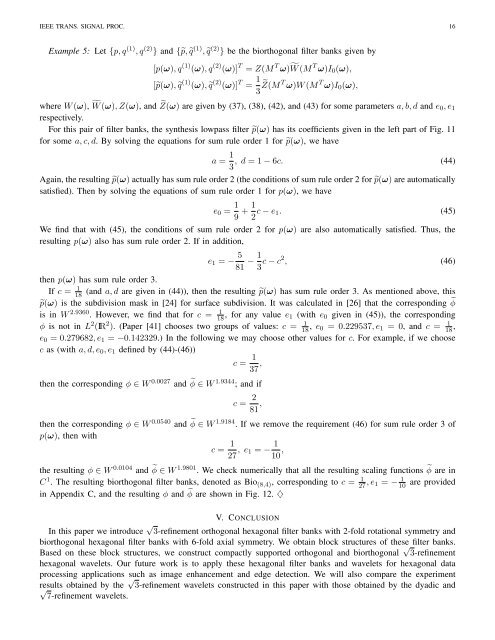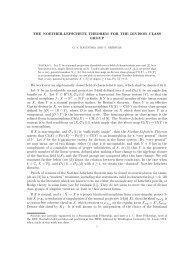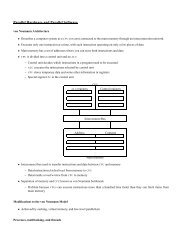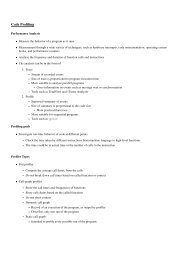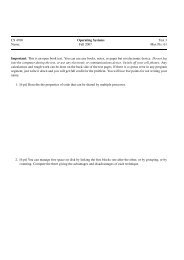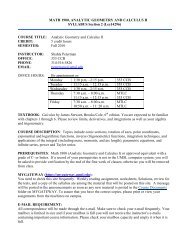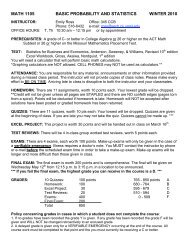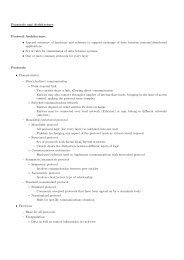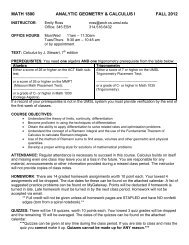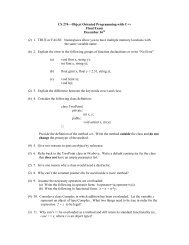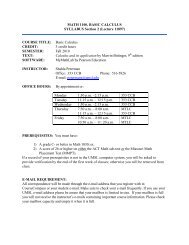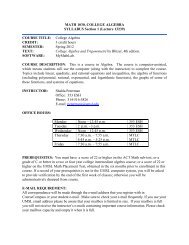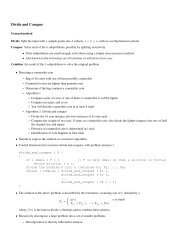here - UMSL : Mathematics and Computer Science - University of ...
here - UMSL : Mathematics and Computer Science - University of ...
here - UMSL : Mathematics and Computer Science - University of ...
You also want an ePaper? Increase the reach of your titles
YUMPU automatically turns print PDFs into web optimized ePapers that Google loves.
IEEE TRANS. SIGNAL PROC. 16<br />
Example 5: Let {p, q (1) , q (2) } <strong>and</strong> {˜p, ˜q (1) , ˜q (2) } be the biorthogonal filter banks given by<br />
[p(ω), q (1) (ω), q (2) (ω)] T = Z(M T ω)˜W (M T ω)I 0 (ω),<br />
[˜p(ω), ˜q (1) (ω), ˜q (2) (ω)] T = 1 3 ˜Z(M T ω)W (M T ω)I 0 (ω),<br />
w<strong>here</strong> W (ω), ˜W (ω), Z(ω), <strong>and</strong> ˜Z(ω) are given by (37), (38), (42), <strong>and</strong> (43) for some parameters a, b, d <strong>and</strong> e 0 , e 1<br />
respectively.<br />
For this pair <strong>of</strong> filter banks, the synthesis lowpass filter ˜p(ω) has its coefficients given in the left part <strong>of</strong> Fig. 11<br />
for some a, c, d. By solving the equations for sum rule order 1 for ˜p(ω), we have<br />
a = 1 , d = 1 − 6c. (44)<br />
3<br />
Again, the resulting ˜p(ω) actually has sum rule order 2 (the conditions <strong>of</strong> sum rule order 2 for ˜p(ω) are automatically<br />
satisfied). Then by solving the equations <strong>of</strong> sum rule order 1 for p(ω), we have<br />
e 0 = 1 9 + 1 2 c − e 1. (45)<br />
We find that with (45), the conditions <strong>of</strong> sum rule order 2 for p(ω) are also automatically satisfied. Thus, the<br />
resulting p(ω) also has sum rule order 2. If in addition,<br />
e 1 = − 5<br />
81 − 1 3 c − c2 , (46)<br />
then p(ω) has sum rule order 3.<br />
If c = 1 18<br />
(<strong>and</strong> a, d are given in (44)), then the resulting ˜p(ω) has sum rule order 3. As mentioned above, this<br />
˜p(ω) is the subdivision mask in [24] for surface subdivision. It was calculated in [26] that the corresponding ˜φ<br />
is in W 2.9360 . However, we find that for c = 1<br />
18 , for any value e 1 (with e 0 given in (45)), the corresponding<br />
φ is not in L 2 (IR 2 ). (Paper [41] chooses two groups <strong>of</strong> values: c = 1<br />
18 , e 0 = 0.229537, e 1 = 0, <strong>and</strong> c = 1 18 ,<br />
e 0 = 0.279682, e 1 = −0.142329.) In the following we may choose other values for c. For example, if we choose<br />
c as (with a, d, e 0 , e 1 defined by (44)-(46))<br />
c = 1<br />
37 ,<br />
then the corresponding φ ∈ W 0.0027 <strong>and</strong> ˜φ ∈ W 1.9344 ; <strong>and</strong> if<br />
c = 2<br />
81 ,<br />
then the corresponding φ ∈ W 0.0540 <strong>and</strong> ˜φ ∈ W 1.9184 . If we remove the requirement (46) for sum rule order 3 <strong>of</strong><br />
p(ω), then with<br />
c = 1<br />
27 , e 1 = − 1 10 ,<br />
the resulting φ ∈ W 0.0104 <strong>and</strong> ˜φ ∈ W 1.9801 . We check numerically that all the resulting scaling functions ˜φ are in<br />
C 1 . The resulting biorthogonal filter banks, denoted as Bio (8,4) , corresponding to c = 1<br />
27 , e 1 = − 1 10<br />
are provided<br />
in Appendix C, <strong>and</strong> the resulting φ <strong>and</strong> ˜φ are shown in Fig. 12. ♦<br />
V. CONCLUSION<br />
In this paper we introduce √ 3-refinement orthogonal hexagonal filter banks with 2-fold rotational symmetry <strong>and</strong><br />
biorthogonal hexagonal filter banks with 6-fold axial symmetry. We obtain block structures <strong>of</strong> these filter banks.<br />
Based on these block structures, we construct compactly supported orthogonal <strong>and</strong> biorthogonal √ 3-refinement<br />
hexagonal wavelets. Our future work is to apply these hexagonal filter banks <strong>and</strong> wavelets for hexagonal data<br />
processing applications such as image enhancement <strong>and</strong> edge detection. We will also compare the experiment<br />
results obtained by the √ 3-refinement wavelets constructed in this paper with those obtained by the dyadic <strong>and</strong><br />
√<br />
7-refinement wavelets.


